Intrinsic Motivation
- Sense of achievement;
- Recognition of work;
- Job Enrichment;
- Higher responsibilities;
- Growth.
Herzberg (1987) believes that the main motivators for employees are the factors which he calls the “motivators” which comprise of the following:
Achievement
Young people expect to achieve the best and for that they can put extra effort for it. The young employees must be given the impression that the work they will succeed doing will get them recognized and will help them achieve the next step which may be getting a better job or assigned to a challenging project/department.
Recognition
The managers must recognize the work the young executives are doing at SWC. When an employee is completing work which requires recommendation or simply telling him “You did a good job” is an easy way to showing that the manager is recognizing the work he/she has done. So simple measures are dropping in an e-mail saying “good work” or telling them this in an office party will give motivation.
Work itself
The work or the job description of the employees must be enhanced in order to increase the scope and breadth of job. Therefore job enrichment is the an essential feature for motivation. Job enrichment is expected to reduce absenteeism, increase intrinsic motivation, and job involvement (Orpen, 1979; Herzberg 1987).
Responsibility
Higher degree of responsibility is an essential motivator. Herzberg (1987) found that responsibility is one factor which led to extreme motivation in job. Therefore higher the degree of responsibility for high achiever, greater the motivation they will derive from the job.
Growth
Career planning is an inevitable part of the motivational aspect of young employees. Young employees are ambitious. They have dreams and goals which they like to see being fulfilled through the present job they are ding. Therefore showing them that this work is a ladder to make them achieve their goal is important and an inevitable motivator.
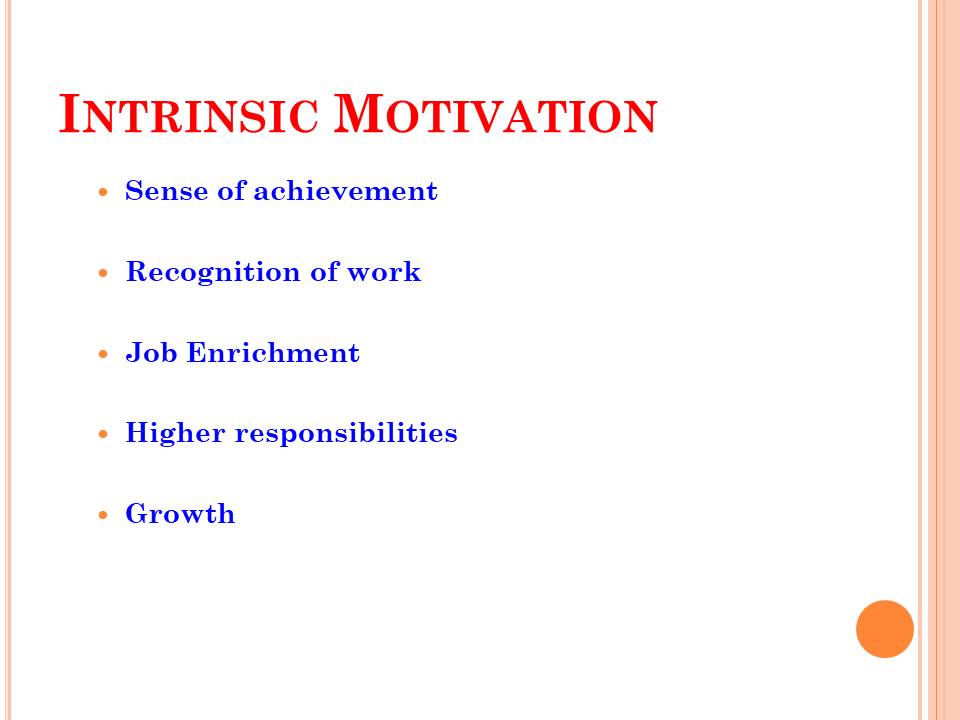
Extrinsic Motivation
- Company policy and Administration;
- Supervision;
- Relationship with superiors;
- Relationship with peers;
- Salary;
- Relationship with subordinates;
- Status;
- Security.
According to Herzberg, the absence of “hygiene” factors led to dissatisfaction among employees. Here the hygiene factors indicate that the absence of these will reduce employee dissatisfaction, however, the presence of these does not indicate that the employee will be motivated. However, these are important in order to keep the employee not getting “dissatisfied”: with the job. Further these are also a source of extrinsic motivation for the employees. The factors which need to be taken care of here are:
Company policy and Administration
If the employee is not satisfied with the company policy or conduct he will be dissatisfied with his job. On the other hand a compatible and good company policy will enhance his extrinsic motivation.
Supervision
If the employee feel there is a lack of supervision or too much supervision, he may be dissatisfied.
Relationship with superiors
Sometimes employees do not like their senior or their conduct. As juniors they cannot negate their supervisors however, are dissatisfied due to their conduct.
Relationship with peers
If there is an introvert in a group of extroverts, the former will obviously feel out of place as their personality do not match. This may lead to a sense of dissatisfaction for the employees.
Salary
Sometimes jobs pay much less than the competitive market rate. Or in case of variable pay, this may lead to a dissatisfaction if an employee finds out that his peer is being paid more (Ducharme & Podolsky, 2006; Rynes, Gerhart, & Minette, 2004). This might be a source of dissatisfaction for the employees.
Relationship with subordinates
Status
Job status is a major source of dissatisfaction if the employee perceives it to a less than what he expects it to be.
Security
Maslow (Robbins & Judge, 2009) indicated that as there is greater need for security ranks higher than physiological need and therefore provides a great deal of extrinsic motivation.

Best Motivating Model
Frederick Herzberg’s Hygiene Factors Model
The best motivational model according to me is that by Fredrick Herzberg (Herzberg, 1987; Robbins & Judge, 2009). The model demonstrates that there are two set of factors which Herzberg calls Hygiene and Motivation factors. Hygiene factors are those which help in not making the employee dissatisfied with the job and the motivators are those which help in providing motivation for the work. In this respect the Motivators as stated by Herzberg are achievement, recognition of work, job enrichment, responsibilities, and growth. The hygiene factors are Company policy and Administration, supervision, Relationship with superiors, Relationship with peers, Salary, Relationship with subordinates, Status, and Security.
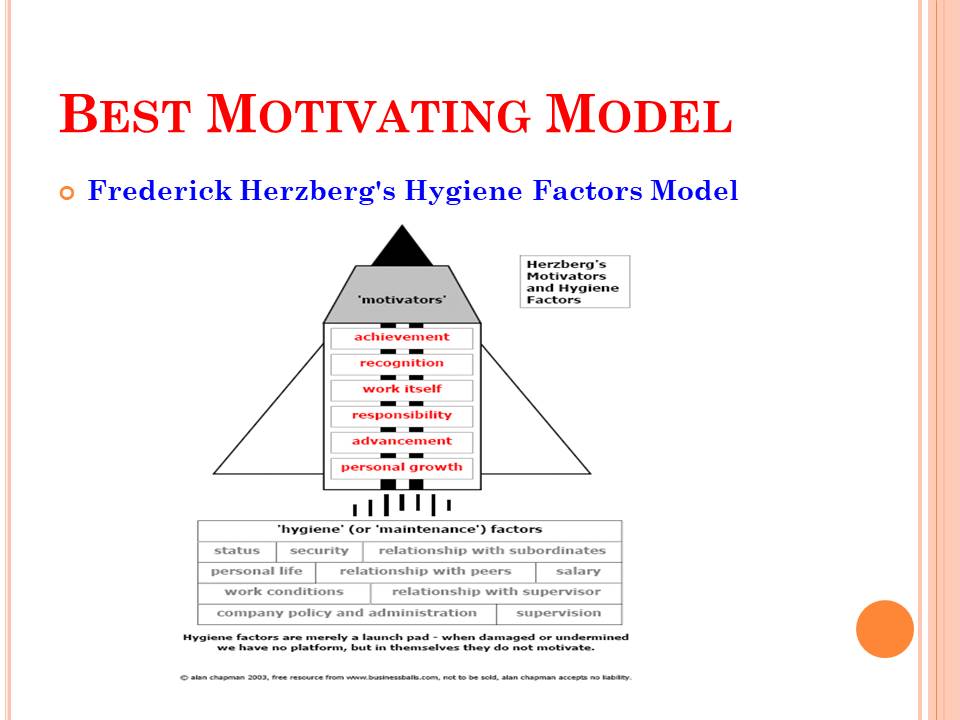
Comparing Conflict Resolution Techniques
No career development
- Young employees are eager to grow fast;
- They intend to see their goals being fulfilled.
In case of SWC employees, the young group of employees feel that there is a lack of career development and path being etched by the company for them. They are not sure what their company for their future. Young people are very careerist and are keen to see themselves growing in the organization. They want to be clear of the hurdles that will come across their way and intend to be sure of it.
Young people have different ideologies. They grow up on a different kind of value system due to differences in value systems. Therefore it is important to understand the values of the young people and to assert the rightness on them.

Conflict Stimulation Techniques
Role Clarity
- There was no clarity as to the job that is expected out of the young employees.
Problem with Superior
- Incompatibility with the supervisors;
- Moral and ethical difference;
- Difference in attitude and outlook.
At SWC, the employees are said to have no clarity of the job they are expected to perform. They are unsure what are their distinct roles and for what they will be evaluated for their performance. This role ambiguity if often a source of lack of motivation for the employees and they feel an animosity towards the organization which takes form of a conflict.
Incompatible and hostile relation with the supervisor may be a source of interpersonal conflict between employees. Further in case of a young employee with a very old superior may become a source of conflict as usually there are differences among people due to age gap. Another issue might be the management style of the supervirsor which may be a source of conflict.
Excessive Supervisory Control
- The supervisor is not supportive;
- Micro control;
- Non recognition of work.
Increasing Salary
- Dissatisfaction with salary;
- Lower than industry standard;
- Variable pay system.
Here we have presented a two kinds o f conflicts which may arise and the main components of each. They demonstrate that the first is a conflict between the supervisor and the junior and the other is between the management and the employees.
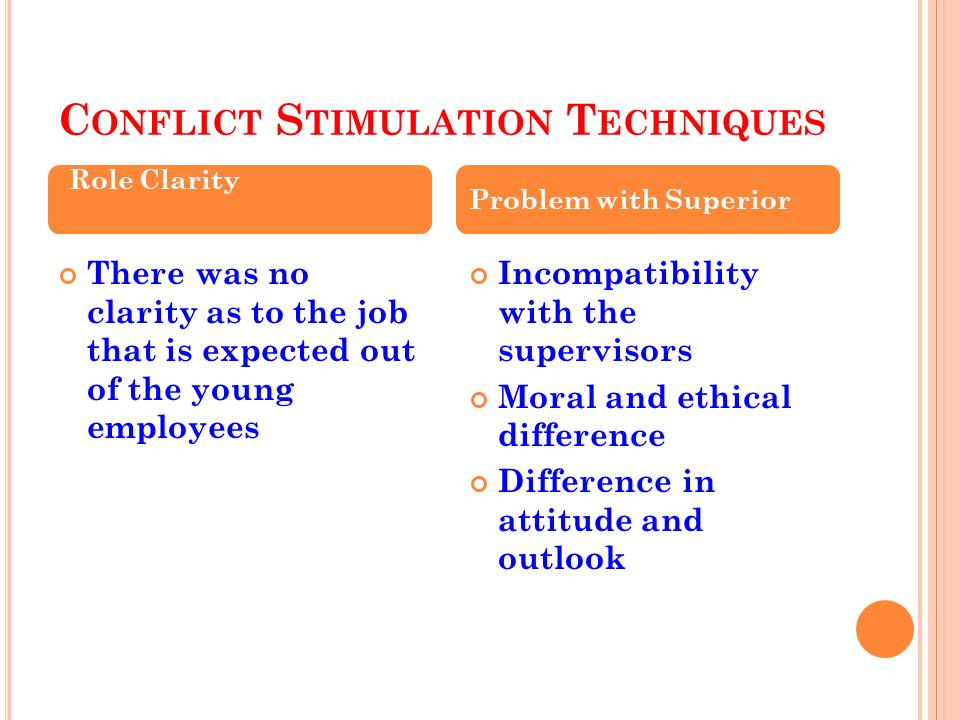
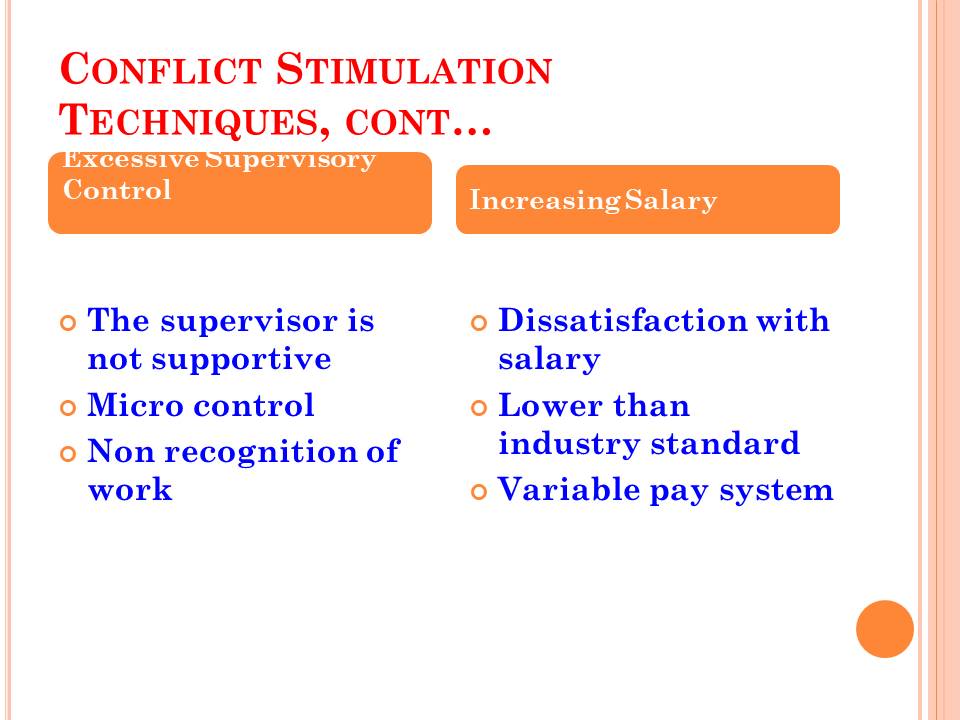
Integrating Bargaining
- Removing some control;
- Job enrichment;
- Establishing a recognition policy;
- Salary estimation based on job description;
- Non monetary recognition;
- Benchmarking of salary.
Removal of control will increase breathing space for employees and it will motivate them further. Increasing the scope of job will enhance their motivation. Giving employees a completely different work unit which they can work on alone and without any substantive supervision. Making periodic reports may be an option wherein employees can make reports to show the work they have achieved.
Granting employees additional freedom and responsibility. This can be done through recognition and job enrichment. Assigning more difficult and specialized tasks to the employees will help in job enrichment. Establishing a recognition policy wherein the supervisor must recognize any good work done by the employees.
Salary estimation based on job description will enable the company to relate the job key result areas which are quantifiable targets to be associated with the performance measure of the employees. This will further formalize the measure wherein performance related salary can be established. Further a 360 degree procedure must be enforced which would decrease the superior-junior animosity.
Non monetary recognition and compensation in terms of fringe benefits. This component should be increased in order to enhance the satisfaction of the employees. Industry based benchmarking of salary must be done in order to estimate the relative position of the pay packages offered by the company. This measure will help in estimating if an increase is actually required or not.
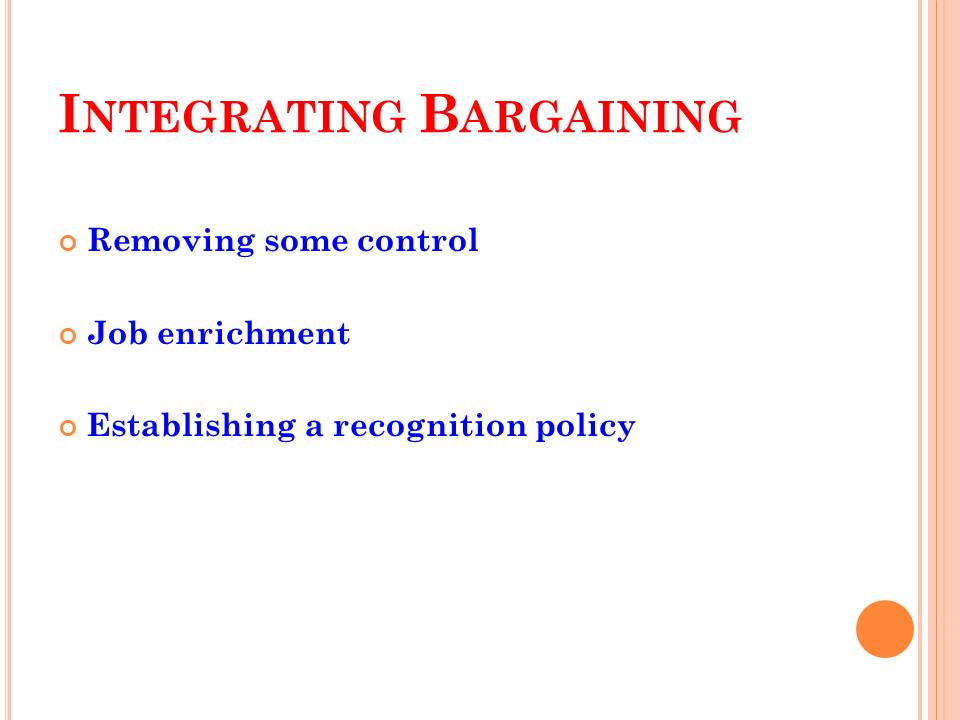
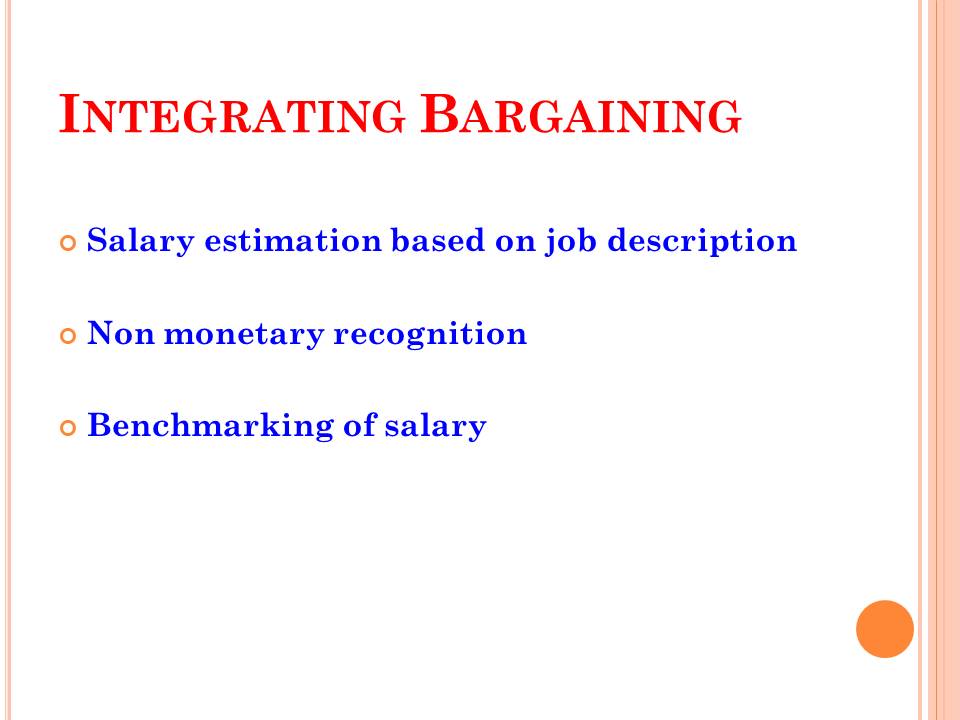
References
Ducharme, M. J., & Podolsky, M. (2006). Variable pay: its impact on motivation and organisation performance. International Journal of Human Resources Development and Management Vol. 6 No. 1 , 8-76.
Herzberg, F. (1987). One more time: How do you motivate employees? Harvard Business Review , 5-16.
Orpen, C. (1979). The Effects of Job Enrichment on Employee Satisfaction, Motivation, Involvement, and Performance: A Field Experiment. Human Relations Vol. 32 No. 3 , 189-217.
Robbins, S. P., & Judge, T. A. (2009). Organizational Behavior (13th Edn). New York: Prentice Hall.
Rynes, S. L., Gerhart, B., & Minette, K. A. (2004). The Importance Of PayIn Employee Motivation: Discrepancies Between What People Say And What They Do. Human Resource Management Vol. 43, No. 4 , 381–394.